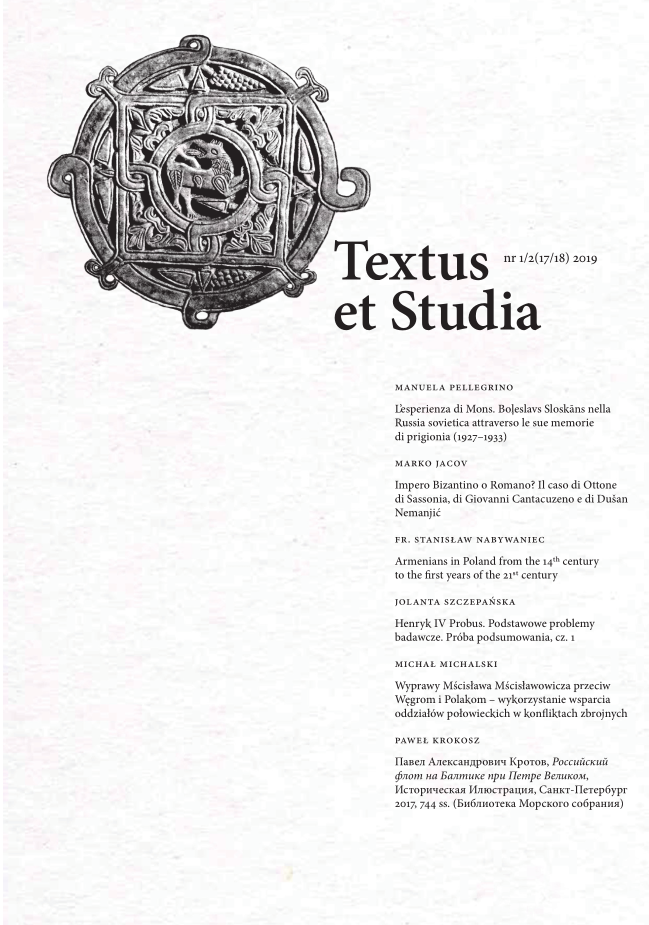Armenians in Poland from the 14th century to the first years of the 21st century
DOI:
https://doi.org/10.15633/tes.05103Słowa kluczowe:
Ormianie, kolonie ormiańskie, katolickie arcybiskupstwo ormiańskie we Lwowie, handel orientalny, Królestwo Polskie, Polska, Rzeczpospolita, Ruś CzerwonaAbstrakt
The first groups of Armenians arrived in Red Ruthenia, Podolia, and Kyiv Ruthenia as early as in the 11th century as part of the first wave of exiles before the Seljuk invasion. At the same time the first Armenian settlements in these Polish lands were established. However, a significant development tendency of the Armenian settlement can only be mentioned concerning the reign of Casimir the Great, who also contributed to the raise of the Armenian church in Lviv to the rank of a cathedral. The greatest development of the Armenian settlement in the Polish-Lithuanian Commonwealth took place in the 16th and 17th centuries. At the end of the 17th century, Armenian settlements stretched along the entire south-eastern border of the Republic of Poland. The Armenian colonies in the former Polish-Lithuanian Commonwealth played an important role in the organization of eastern trade. A trade route connecting the East with the West ran through the territory of the Republic of Poland. Apart from economic activity, Armenians played a significant role in the field of diplomacy. All Armenian colonies in the territory of the Republic of Poland enjoyed autonomy. The outbreak of the war in 1939 meant that Poles and Armenians shared the tragic fate. World War II dispersed the Polish Armenians. Some of them – mainly Armenians from the city of Kuty and its surroundings – were murdered in 1943–1944 by the Ukrainians, with the approval of the Germans. Others were taken to Soviet camps or sent to Central Asia. Few Armenians remained in Lviv. Polish Armenians who survived lived in postwar Poland. After the political transformation that took place in Poland and other countries of Central and Eastern Europe, new emigrants from Armenia come to Poland. According to the 2002 national population and housing census, 262 citizens of the Republic of Poland declared themselves as Armenians.
Bibliografia
Balzer O., Statut ormiański w zatwierdzeniu Zygmunta I z roku 1519, Lwow 1910.
Barącz S., Rys dziejów ormiańskich, Kraków 1869.
Bardach J., Ormianie na ziemiach dawnej polskich, “Kwartalnik Historyczny” 1983, nr 90, pp. 109–118.
Biedrońska-Słotowa B., Ormianie polscy odrębność i asymilacja, Kraków 1999.
Bohosiewicz A., Powojenna historia Ormian polskich, “Horyzonty Wiary”
–1999, nr 9–10, http://www.bohosiewicz.ip.pl/Powojenna.
html [accessed: 7.05.2019].
Centro Studi Immigrazione, Le migrazioni interne in Europa (Centro
Italiano di Formazione Europea), http://www.cestim.org/dossier_
migrazioni/parte_2/interne.htm [accessed: 7.05.2019].
Chowaniec C., Ormianie w Stanisławowie w XVII i XVIII wieku, Stanisławów 1928.
Daszkewycz J., Likwidacija wirmeno-kaatołyćkoji Cerkwy w Hałyczynie, Lwiw 1998.
Gołębiowski K., Ormianie w Polsce, http://www1.gazeta.pl/swiat/1,34296,
html [accessed: 21.03.2005].
Gromnicki T., Ormianie w Polsce [in:] Encyklopedia Kościelna, t. 17, M. Nowodworski (red.), Warszawa 1891.
http://www.lwow.home.pl/orm.html [accessed: 7.05.2019].
http://www.mswia.gov.pl/mn_narod_ormianie.html [accessed: 21.03.2005].
Korwin L., Ormiańskie rody szlacheckie w Polsce, Kraków 1934.
Lewicki T., O Ormianach zamojskich, “Kwartalnik Historyczny” 1966,
nr 73, pp. 407–411.
Mak A., Wierni Polsce od 800 lat. Ormianie, http://www.opoka.org.pl/
biblioteka/Z/ZD/ormianie.html [accessed: 7.05.2019].
Mańkowski T., Orient w Polskiej kulturze artystycznej, Wrocław–Kraków 1959.
Nabywaniec S., Armeni-Cattolici in Polonia prima e dopo il 1989, “Citta di Vita” 2007, no. 6, pp. 593–596.
Oganiesian M., Autonomia Ormiańska w Rzeczpospolitej w XVI–XVII wieku [in:] Studia z dziejów kontaktów polsko-ormiańskich, M. Zakrzewska-Dubasowa (red.), Lublin 1983, pp. 68–89.
Okraska R., Ormianie polscy, “Zakorzenienie” 2000, nr 6(8), http://www.
zakorzenienie.most.org.pl/za8/04.htm [accessed: 7.05.2019].
Petrowicz G., La Chiesa Armena in Polonia e nei paesi limitori, part. 3: 1686–1954, Roma 1988.
Pisowicz A., Sześćsetpięćdziesiąt lat Ormian polskich, “Cracovia-Leopolis” 1998, nr 15, pp. 13–16.
Podhorecki L., Chocim 1621, Warszawa 1988.
Quirini-Popławska D., Polska azylem europejskich emigrantów na przełomie wieków średnich i nowożytnych, “Odrodzenie i Reformacja w Polsce” 1993, nr 23, pp. 35–46.
Stopka K., Ormianie w Polsce dawnej i dzisiejszej, Kraków 2000.
Suchanik J., Ormianie w Polsce, “Rocznik Wschodni” 2004, nr 10–11, pp. 11–22.
Tabińska-Juhasz D., Kresowi Ormianie, http://www.lwow.home.pl/semper/kresowi.html [accessed: 7.05.2019].
Tyszka M., Diecezje Kościoła ormiańskokatolickiego u progu trzeciego tysiąclecia, “Biuletyn OTK” 2002, nr 28–29, pp. 25–26.
Woźniak K.A., Ormianie polscy, http://www.bohosiewicz.ip.pl/text15.htm [accessed: 7.05.2019].
Zakrzewska-Dubasowa M., Historia Armenii, Wrocław–Kraków–Gdańsk 1977.
Zaleski T., Ks. Prałat Leon Isakowicz − proboszcz ormiański i kustosz sanktuarium w Stanisławowie. Zarys biograficzny, “Biuletyn OTK” 2001, nr 24–25, pp. 14–18.
Pobrania
Opublikowane
Numer
Dział
Licencja
Prawa autorskie (c) 2021 Stanisław Nabywaniec

Praca jest udostępniana na licencji Creative Commons Attribution-NonCommercial-NoDerivatives 3.0 Unported License.
Autorzy publikujący w czasopiśmie udzielają jego wydawcy zgody o następującej treści:
- Autor zachowuje autorskie prawa majątkowe do utworu, a jednocześnie udziela wydawcy czasopisma zgody na jego pierwszą publikację w wersji drukowanej i wersji online na licencji Creative Commons Uznanie autorstwa 4.0 Międzynarodowe oraz zgody na wykonywanie opracowań, w tym przekładów.
- Autor ma możliwość udzielania zgody niewyłącznej na opublikowanie utworu w wersji, która ukazała się w czasopiśmie (np. zamieszczenia go w repozytorium instytucjonalnym lub opublikowania w książce), wraz z informacją o jego pierwszej publikacji w czasopiśmie.
- Autor może umieścić swój utwór online (np. w repozytorium instytucjonalnym lub na swojej stronie internetowej) jeszcze przed zgłoszeniem utworu do czasopisma.

